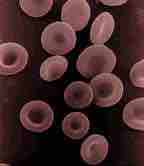Human erythrocytes or red blood cells (RBCs) are the primary cellular component of blood. They are involved in oxygen transport through the body and have features that distinguish them from every other type of human cell. Adult humans have roughly 20-30 trillion RBCs at any given time, comprising approximately one quarter of the total number of human cells.
External Structure
RBCs are disc-shaped with a flatter, concave center. This biconcave shape allows the cells to flow smoothly through the narrowest blood vessels. Gas exchange with tissues occurs in capillaries, tiny blood vessels that are only as wide as one cell. Many RBCs are wider than capillaries, but their shape provides the needed flexibility to squeeze through.

Red blood cells
Human red blood cells (6–8μm)
A typical human RBC has a disk diameter of 6–8 micrometers and a thickness of 2 micrometers, much smaller than most other human cells. These cells have an average volume of about 90 femtoliters (fL) with a surface area of about 136 square micrometers. They can swell up to a sphere shape containing 150 fL without bursting their cell membrane. When the shape does change, it inhibits their ability to carry oxygen or participate in gas exchange. This occurs in people with spherocytic (sphere-shaped) anemia or sickle-cell anemia.
Internal Structure
Although RBCs are considered cells, they lack a nucleus, nuclear DNA, and most organelles, including the endoplasmic reticulum and mitochondria. RBCs therefore cannot divide or replicate like other labile cells of the body. They also lack the components to express genes and synthesize proteins. While most cells have chemotaxic ways to travel through the body, RBCs are carried through the body by blood flow and pressure alone.
Hemoglobin molecules are the most important component of RBCs. Hemoglobin is a specialized protein that contains a binding site for the transport of oxygen and other molecules. The RBCs' distinctive red color is due to the spectral properties of the binding of hemic iron ions in hemoglobin. Each human red blood cell contains approximately 270 million of these hemoglobin biomolecules, each carrying four heme groups (individual proteins). Hemoglobin comprises about a third of the total RBC volume. This protein is responsible for the transport of more than 98% of the oxygen, while the rest travels as dissolved molecules through the plasma.